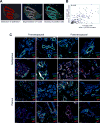The Proliferative Activity of Mammary Epithelial Cells in Normal Tissue Predicts Breast Cancer Risk in Premenopausal Women
- PMID: 26941287
- PMCID: PMC4873436
- DOI: 10.1158/0008-5472.CAN-15-1927
The Proliferative Activity of Mammary Epithelial Cells in Normal Tissue Predicts Breast Cancer Risk in Premenopausal Women
Abstract
The frequency and proliferative activity of tissue-specific stem and progenitor cells are suggested to correlate with cancer risk. In this study, we investigated the association between breast cancer risk and the frequency of mammary epithelial cells expressing p27, estrogen receptor (ER), and Ki67 in normal breast tissue. We performed a nested case-control study of 302 women (69 breast cancer cases, 233 controls) who had been initially diagnosed with benign breast disease according to the Nurses' Health Studies. Immunofluorescence for p27, ER, and Ki67 was performed on tissue microarrays constructed from benign biopsies containing normal mammary epithelium and scored by computational image analysis. We found that the frequency of Ki67(+) cells was positively associated with breast cancer risk among premenopausal women [OR = 10.1, 95% confidence interval (CI) = 2.12-48.0]. Conversely, the frequency of ER(+) or p27(+) cells was inversely, but not significantly, associated with subsequent breast cancer risk (ER(+): OR = 0.70, 95% CI, 0.33-1.50; p27(+): OR = 0.89, 95% CI, 0.45-1.75). Notably, high Ki67(+)/low p27(+) and high Ki67(+)/low ER(+) cell frequencies were significantly associated with a 5-fold higher risk of breast cancer compared with low Ki67(+)/low p27(+) and low Ki67(+)/low ER(+) cell frequencies, respectively, among premenopausal women (Ki67(hi)/p27(lo): OR = 5.08, 95% CI, 1.43-18.1; Ki67(hi)/ER(lo): OR = 4.68, 95% CI, 1.63-13.5). Taken together, our data suggest that the fraction of actively cycling cells in normal breast tissue may represent a marker for breast cancer risk assessment, which may therefore impact the frequency of screening procedures in at-risk women. Cancer Res; 76(7); 1926-34. ©2016 AACR.
©2016 American Association for Cancer Research.
Conflict of interest statement
Figures

References
-
- Society AC. Breast Cancer facts & Figures 2013–2014. Atlanta: American Cancer Society, Inc.; 2013.
-
- Chen WY, Colditz GA. Risk factors and hormone-receptor status: epidemiology, risk-prediction models and treatment implications for breast cancer. Nat Clin Pract Oncol. 2007;4(7):415–23. - PubMed
-
- Inman JL, Robertson C, Mott JD, Bissell MJ. Mammary gland development: cell fate specification, stem cells and the microenvironment. Development. 2015;142(6):1028–42. - PubMed
-
- Colditz GA, Rosner BA, Chen WY, Holmes MD, Hankinson SE. Risk factors for breast cancer according to estrogen and progesterone receptor status. J Natl Cancer Inst. 2004;96(3):218–28. - PubMed
Publication types
MeSH terms
Grants and funding
LinkOut - more resources
Full Text Sources
Other Literature Sources
Medical

